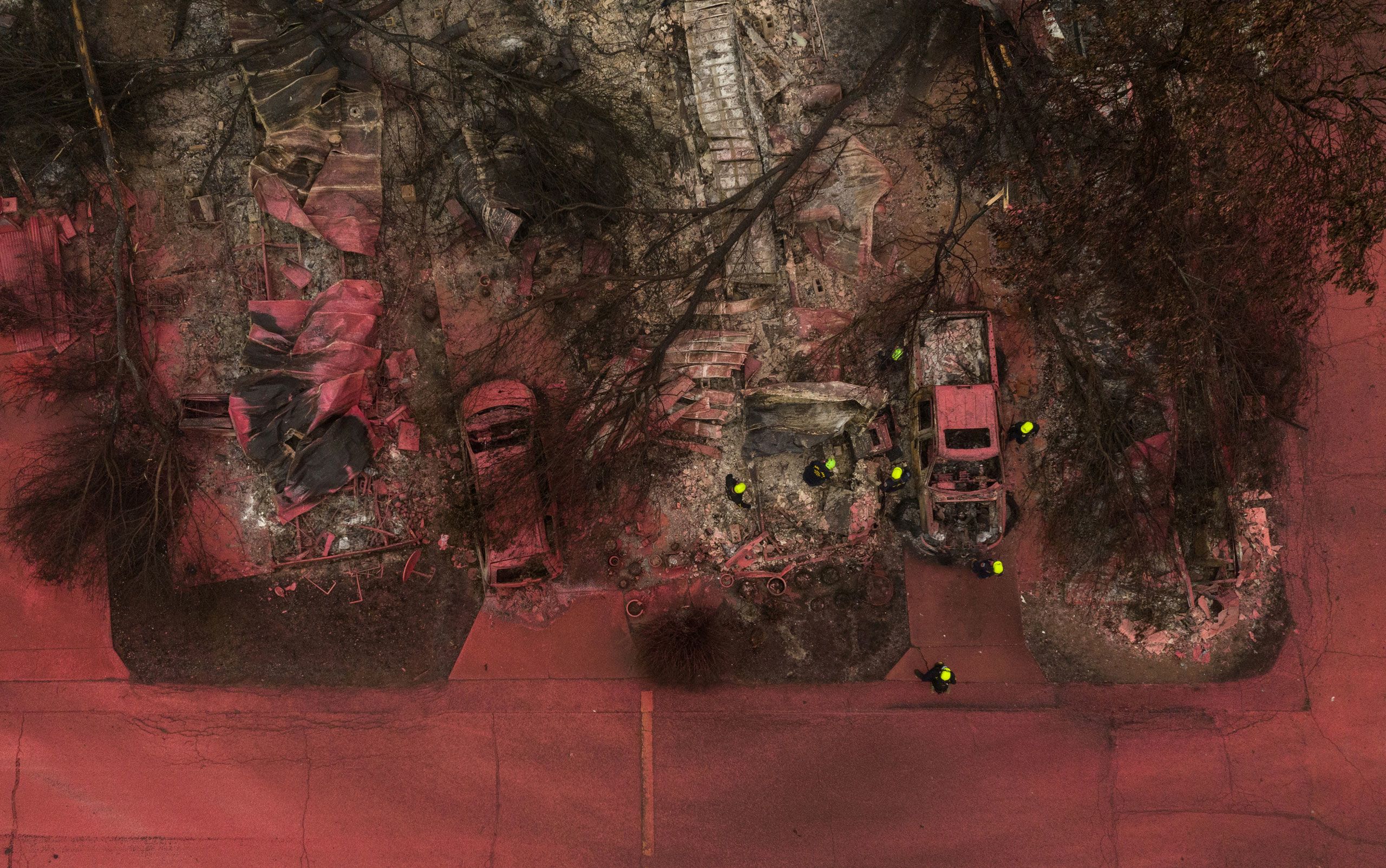COVID sniffer dogs, cave bear and corals — September’s best science images
The month’s sharpest science shots, selected by Nature’s photo team.

Scorched earth. A search-and-rescue team looks for victims under burnt buildings and vehicles in the aftermath of a wildfire in Talent, Oregon. Earlier efforts to extinguish the flames left large areas of the city coated in the red fire-retardant compound ammonium polyphosphate. This year, Oregon has experienced one of the most destructive wildfire seasons on record. In early September, dry weather and strong winds caused thousands of fires to expand, burning more than one million acres of land, destroying homes and displacing thousands of people.

Forest find. The remnants of pine, alder, oak and birch trees thought to have been buried under sand and seawater for 4,500 years have been uncovered by a storm at a beach in Llanrhystud, Wales. The stumps are part of a petrified forest that can sometimes be seen at Borth, Wales, around 21 kilometres farther north. The finding suggests that the ancient woodland might have covered a much wider area than previously thought. Researchers are carrying out tests at the Llanrhystud site to establish the trees’ age.
Credit: Kazi Fazle Rabbi and Xiao Yan/Nikon Small World. This video has no sound.
Credit: Kazi Fazle Rabbi and Xiao Yan/Nikon Small World. This video has no sound.
Droplet dynamics. This video of two coalescing microdroplets was the winner of this year’s Nikon Small World in Motion photomicrography competition. Kazi Rabbi and Xiao Yan at the University of Illinois at Urbana-Champaign captured the film. The microdroplets — made of 80% water and 20% ethanol — ripple as they coalesce on top of a repellent superhydrophobic surface that was designed by the researchers. Their work involves creating materials that could be used to make more energy-efficient products, such as water-repellent surfaces or freeze-resistant pipes. To capture the moment that one droplet swallows up another — which has been slowed down 200 times in the final video — the pair used a high-speed camera interfaced with a microscopic lens.

Credit: NEFU RIAEN
Credit: NEFU RIAEN
Cave bear. A beautifully preserved ancient cave bear (Ursus spelaeus) has been uncovered by the melting permafrost on Siberia’s Lyakhovsky Islands. The remains were found by reindeer herders and include soft tissues and internal organs. An initial analysis suggests the bear is at least 22,000 years old. “This find of great importance to the whole world,” said Lena Grigorieva, a palaeontologist at North-Eastern Federal University in Yakutsk, Russia, in a statement. Until now, only the skulls and bones of cave bears have been found, and scientists are eager to study the specimen. The bodies of several ancient animals, including cave lions (Panthera spelaea), woolly mammoths (Mammuthus primigenius) and woolly rhinos (Coelodonta antiquitatis) have been discovered in the past decade as Siberia’s permafrost thaws.

Credit: NOAA
Credit: NOAA
Gathering storms. On the morning of 14 September, the US National Oceanic and Atmospheric Administration’s GOES-East satellite spotted six tropical storms swirling over the Atlantic and Pacific oceans. They are, from left to right in the image: Tropical Storm Karina in the Pacific, Hurricane Sally over the Gulf of Mexico, Hurricane Paulette over Bermuda, the remnants of Tropical Storm Rene, Tropical Storm Teddy and Tropical Storm Vicky. It is only the second time on record — and the first since 1971 — that five named storms have formed in the Atlantic basin simultaneously.

Credit: Kelly Barnes/Getty
Credit: Kelly Barnes/Getty
Smells like COVID? This is Floki, a springer spaniel that scientists at the University of Adelaide in Australia are training to detect signs of coronavirus infection in human sweat. The research is part of an international effort to train sniffer dogs to rapidly screen people for COVID-19. The training methods are similar to those used with dogs trained to detect drugs or explosives. The canines are rewarded with positive reinforcement — in Floki’s case, being allowed to play with his favourite toy — when they pick a person with COVID-19’s sweat sample out of a line-up. Preliminary studies show that dogs trained in this way are able to identify people who are infected with the coronavirus before they develop symptoms. A pilot scheme involving 4 sniffer dogs at Helsinki airport indicated that dogs can detect the presence of the virus in less than 10 seconds with nearly 100% accuracy.

Credit: LSST Camera Team/SLAC National Accelerator Laboratory/Rubin Observatory
Credit: LSST Camera Team/SLAC National Accelerator Laboratory/Rubin Observatory
A very big Brassica. This 3,200-megapixel image of a Romanesco (Brassica oleracea), a type of broccoli, is one of the largest digital photos ever taken: 378 4K ultra-high-definition television screens would be needed to display the picture at its full size. The photo was taken using an array of imaging sensors that will eventually become part of the world’s largest digital camera, which is under construction. Once complete, the camera will be installed at the Vera C. Rubin Observatory in Chile, where it will capture panoramas of the southern night sky for the next 10 years, collecting images of about 20 billion galaxies.

Credit: ROV SuBastian/Schmidt Ocean Institute
Credit: ROV SuBastian/Schmidt Ocean Institute
Coral capture. The research vessel Falkor, the flagship vessel of the Schmidt Ocean Institute in Palo Alto, California, surveyed the deepest regions of Australia’s Great Barrier Reef during its fourth expedition this year, helped by its remotely operated underwater robot SuBastian. Here, SuBastian’s robotic arms gently grasp a black coral growing on a nautilus shell at a depth of 550 metres near Herald Cays, a region in the Coral Sea northeast of Queensland. This coral was previously classified as belonging to a family called Schizopathidae, but some marine scientists suspect that it might actually belong to a different family. Having collected this specimen, researchers will finally be able to extract and sequence its DNA, and use it to establish which group the coral should belong in. During the expedition, scientists also discovered five previously undescribed species of coral and sponge, and observed the extremely rare scorpionfish Rhinopias agroliba.